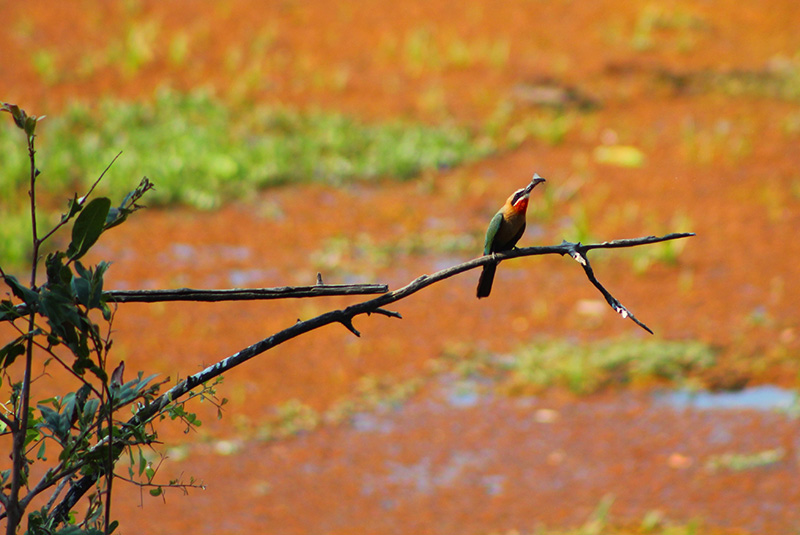Zambia: A Best-Kept Walking Safari Secret

I have heard Zambia described as a safari-lover’s safari, as the place for walking safaris, and as Africa as it was 30 years ago. I’ve heard people say it’s less crowded and a better value than well-known safari spots, and that its camps are refreshingly simple compared to some of the opulence that has sprouted across the continent. There is truth to all of these perspectives, yet what stood out to me after my recent adventure is that Zambia deserves more than to be described in relation to other safari destinations, to be seen as an “alternative safari”. Zambia glows on its own merit. It is top tier, a first-choice destination. Indeed, my Zambia safari was perhaps the best safari I’ve ever experienced.
Consider some of Zambia’s gifts: Victoria Falls needs no introduction. The South Luangwa National Park is where the concept of the walking safari was born and where the guides and walking camps remain matchless. The Luangwa Valley has been called “The Valley of the Leopard,” and I have never seen so many in one safari in my life. The Zambezi River is a geographic marvel. And Zambia’s sustainably grown tourism, with a commitment to reconnection without compromise, is nourishment for the spirit.
And while the walking safaris for which Zambia is known are certainly a breathtaking highlight, there is much more to talk about. Combine them with the traditional game drives, a dash of canoe trips, a river cruise here and there, and sunrise fishing excursions, and you have one of the most diverse safaris on the continent—one you can enjoy without massive crowds of people.
So in some ways, safariing in Zambia does feel like going back to a simpler time, but it is also experiencing the Africa of today. If you are ready for a deeper connection to the land, the people and the wildlife, Zambia is ready to welcome you.
Zambia Safari Tours
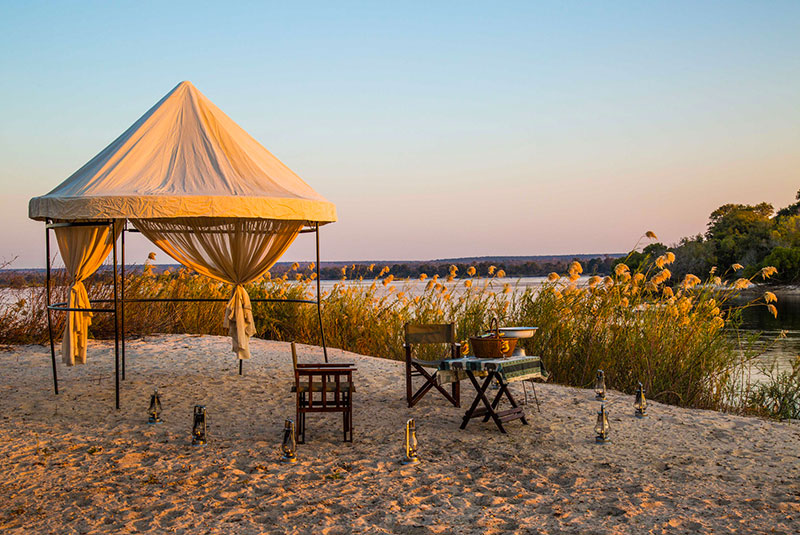
Photo: Classic Portfolio / The River Club
For full disclosure, I did not take the above photo, but I can attest to the beauty of sundowners on the Zambezi on a private island somewhere between Zambia and Zimbabwe, with the river and the sky turning shades of orange and pink, and the anticipation of an al-fresco dinner under the stars back at The River Club. We told stories of Livingstone’s history, passed around croquettes and bottles of Mosi beer, and toasted to days spent helicoptering around Victoria Falls or fishing tranquilly down the river. The only reason I don’t have my own photo to share is because I was too busy absorbing all this beauty to document it!
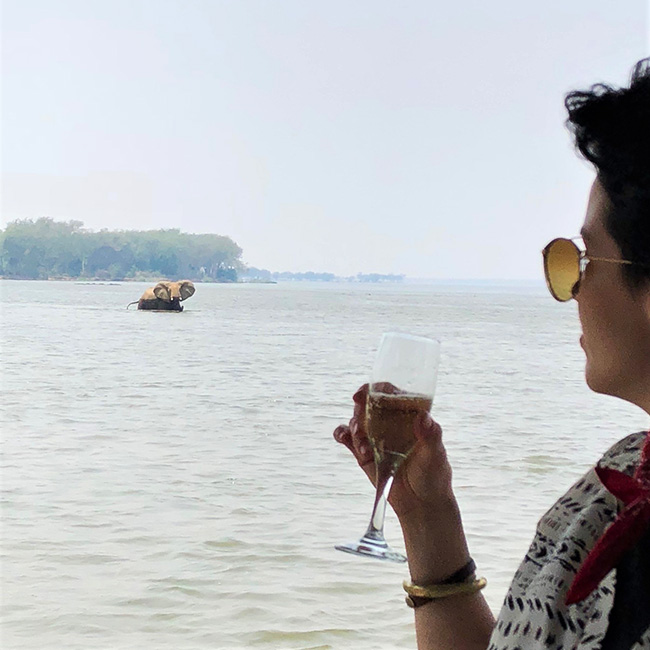
Zambia is a landlocked country, but your trip is never going to be far from water—either physically or psychologically. In a game vehicle, you hold on tight as you drive to a sighting. But during your boating brunch at Chiawa Camp in the Lower Zambezi National Park, you sip champagne while floating placidly past the wildlife that have come to the river for their own nourishment.
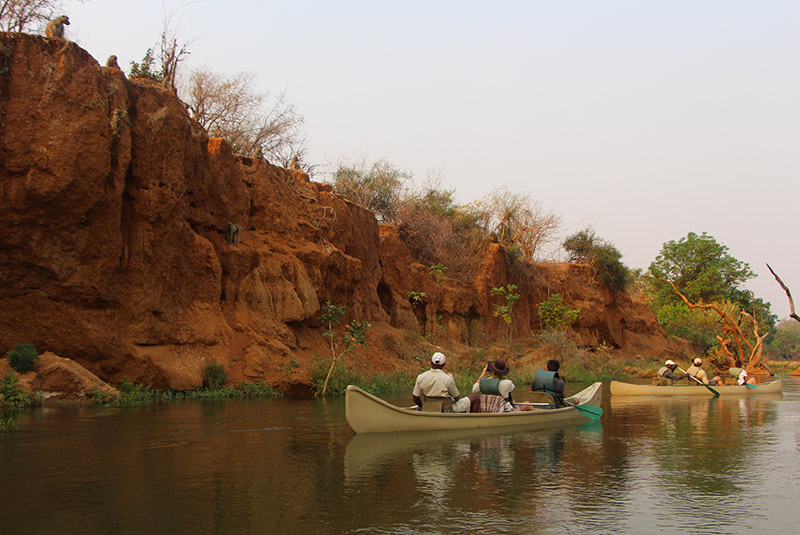
This was a special moment. While on a canoeing excursion from Chiawa Camp, a troop of baboons emerged from the forest and stood atop these red-dirt cliffs, watching us silently.
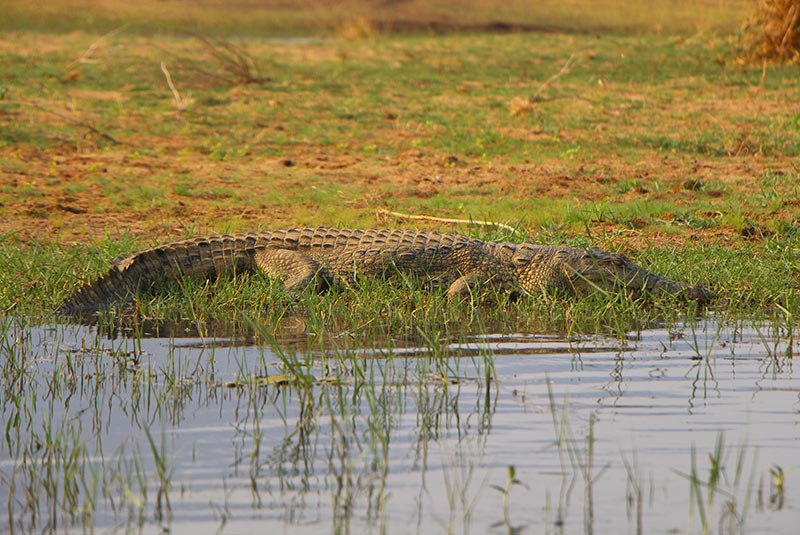
How better to fully appreciate a crocodile’s scales than from the seat of your canoe, mere yards away from this ancient reptile?
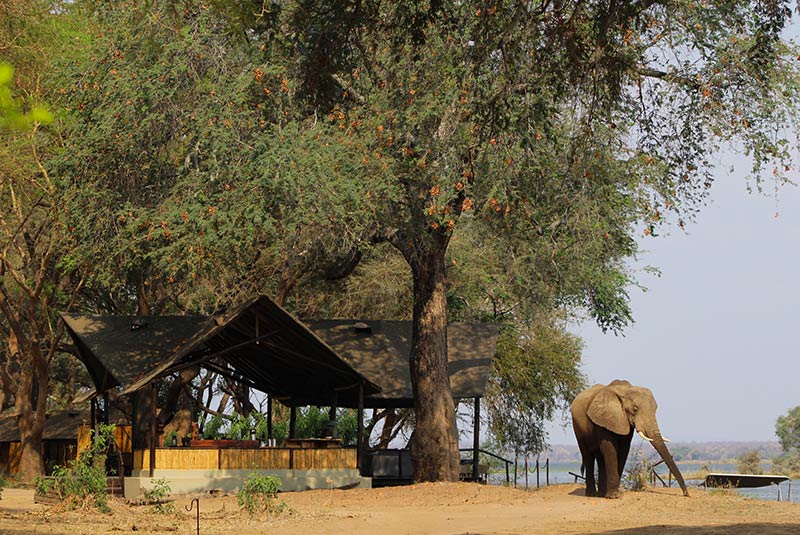
Old Mondoro feels like it’s located in an enchanted forest, with light glittering through the trees, and instead of mythical creatures you have the equally impressive herds of elephants. We dined under the stars with this fellow practically at the head of the table, but rather more preoccupied with the seed pods nearby than the molten-chocolate dessert.
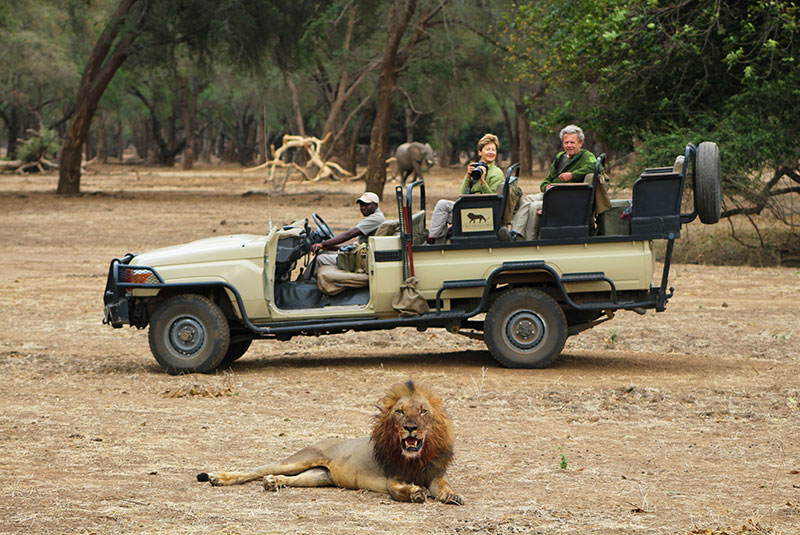
This gaping lion is a member of a trio of brothers—Blackie, Blondie, and Ginger, named for the hues of their manes—all of whom had exhausted themselves by feasting on a buffalo. They nonchalantly allowed us to sit and watch them enjoy their breakfast. We later approached from a safe distance on foot, which made Blackie focus on our movement a bit more mindfully (although we really weren’t interested in asking them to share).
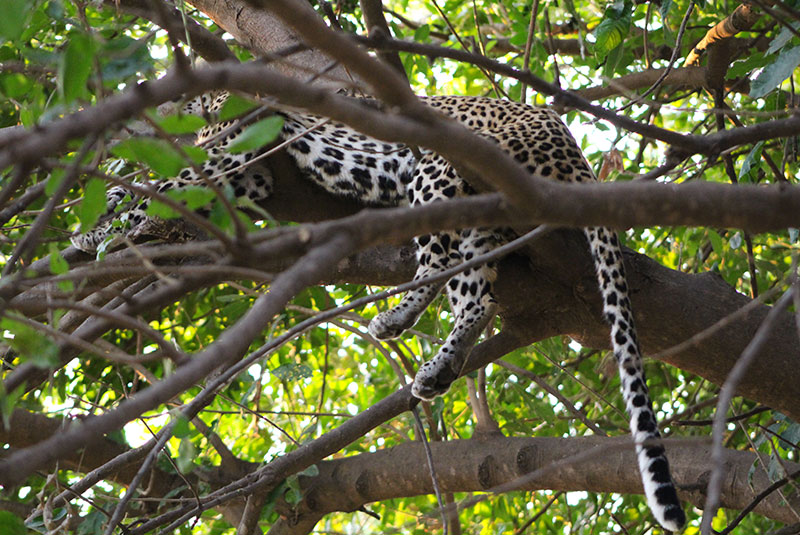
I admit: Better photos of leopards exist, but mine reminds me of how special it is to see this glorious animal in the light of day, her camouflage mixing with the sunlight and the leaves and the branches. We later saw this beautiful leopardess at night, hunting in the vicinity of three other leopards.
Walking Safaris in Zambia
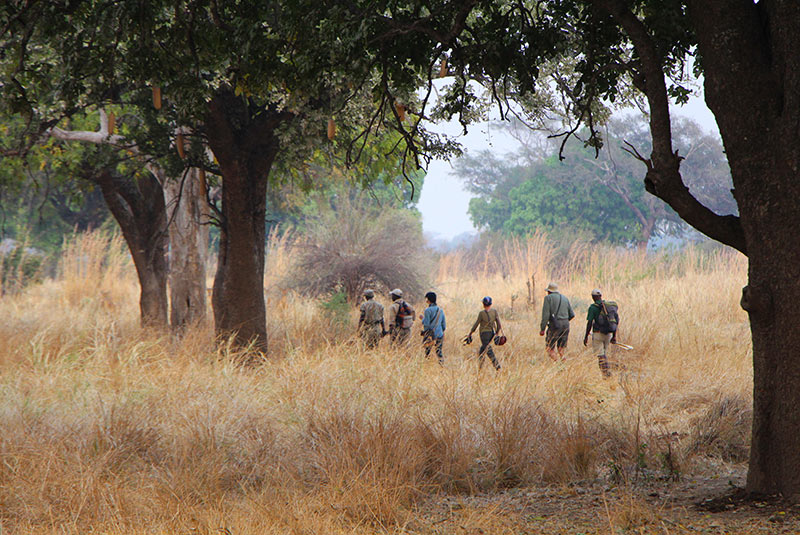
All safari walks in Zambia are carried out in the care of an expert guide—Zambia has some of the best-trained guides in the safari industry throughout Africa—plus an armed scout.
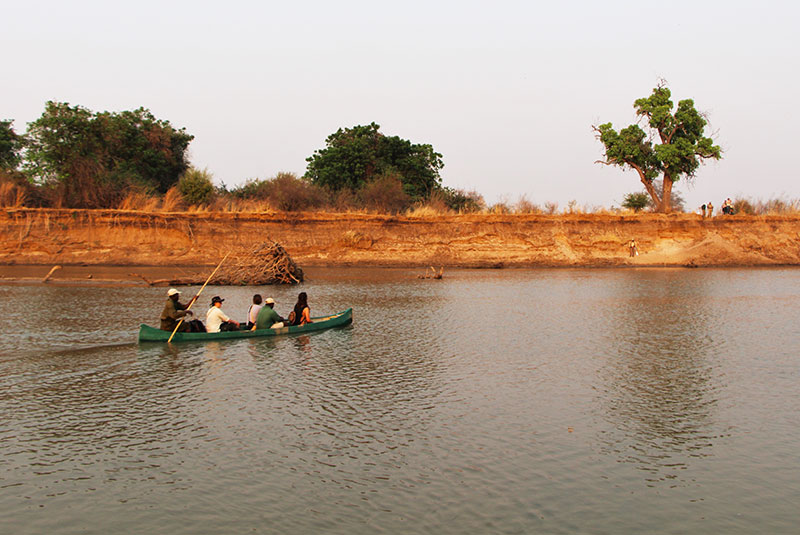
The adventure begins. The hippo snort and retreat to the deep water. You step into the canoe and glide across the Luangwa River to the Chikoko Trails walking experience in South Luangwa National Park. Once you disembark on the other side of the river, you’re on your own two feet all the way into camp.
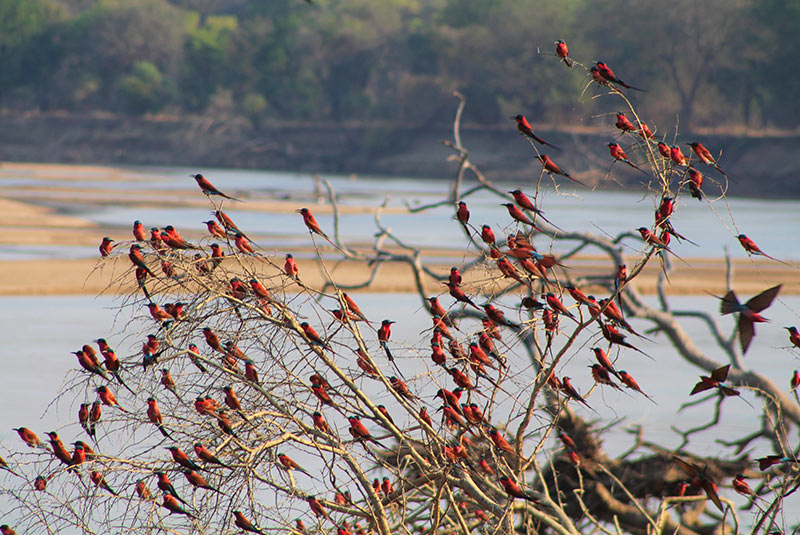
The migratory southern carmine bee-eaters nest along the banks of the Luangwa River from roughly September to November. If you visit during that time of year, leave some unscheduled time just to watch them, because they are mesmerizing. And if you tread too close to the cliffs where they nest…
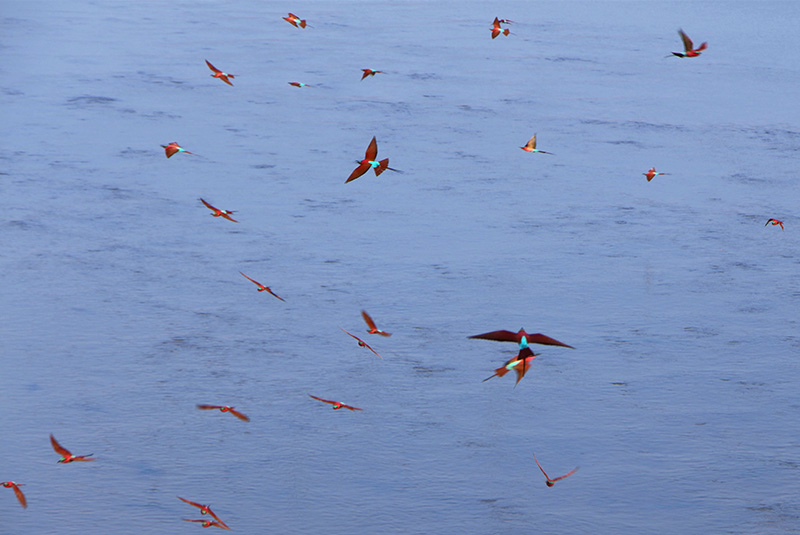
…the ruby-colored birds burst out in a raucous display, swooping over the river before settling in a tree or, somehow, slipping at top speed back into their nesting holes in the cliffs.
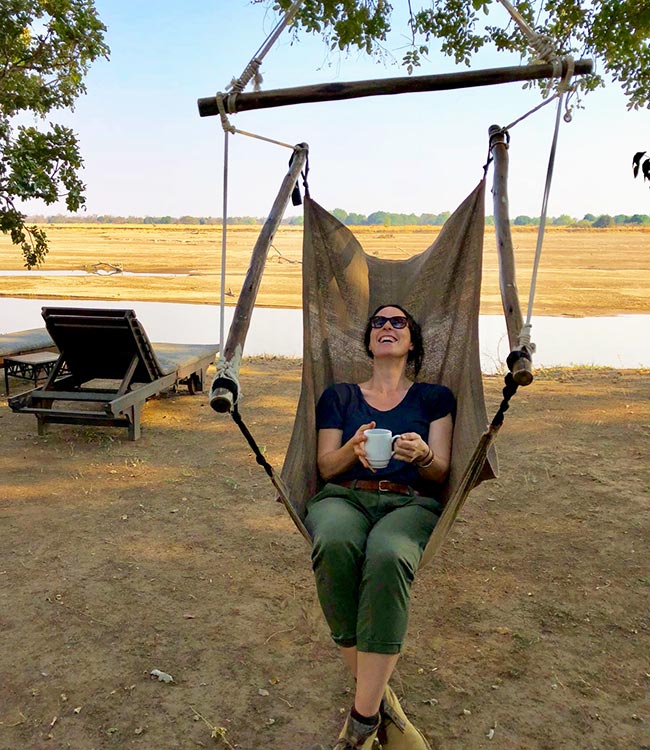
Tafika Camp has front-row seats to what happens on the Luangwa River, although my back is turned in this photo—because I’m clearly enjoying the afternoon tea spread far too much.
Zambia Wildlife
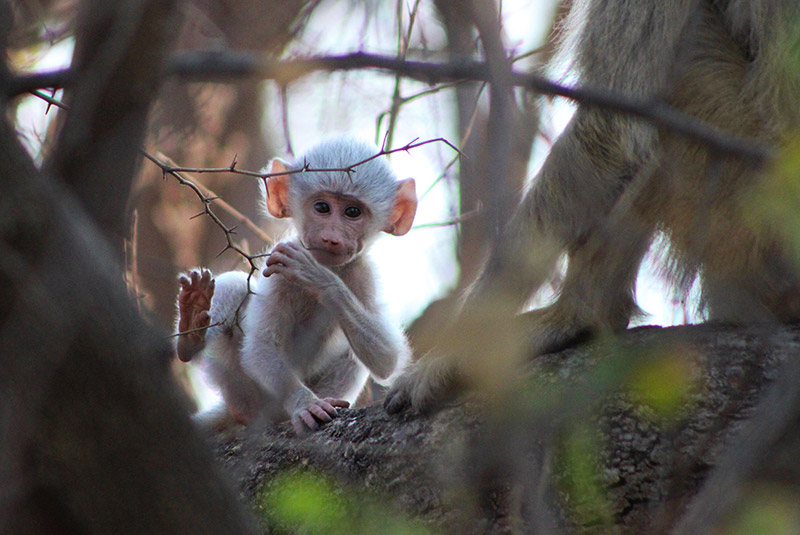
Zambia’s national parks kept giving and giving, not just with the large animals, but with the small ones, too. We spent nearly an hour gushing over this sweet leucistic (reduced pigmentation) baby baboon as he or she played with her cousins in the troop.
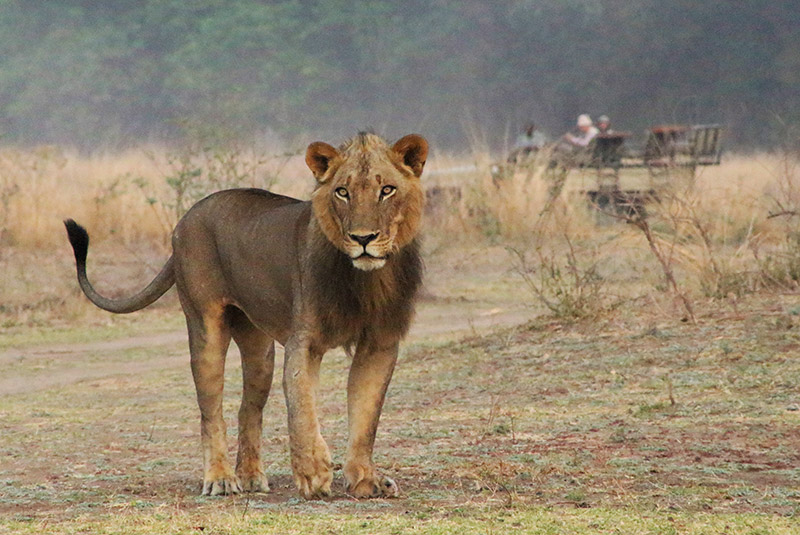
One game drive, this young male and his mate were completely unperturbed by our vehicle, at one point approaching so close to us that I couldn’t take a photo—his face filled my entire lens! They were far more concerned with the alarm calls of a nearby baboon troop, whose panicked barking indicated the presence of leopard. The lions set off into the forest, peering up into trees, searching for this elusive leopard—probably in the hopes of stealing its kill.
In contrast, just a day earlier we’d approached lions from a safe distance on foot. Once you’re outside the vehicle, there’s a new equilibrium when the animals finally recognize you for the human that you are. As we peered at the lounging pride, the lionesses decided they didn’t want to be around us and hustled away to safety. Although it meant my photos are a blur of retreating tails, the experience itself was a whole other world—for the first time, you’re not just seeing the wildlife; they’re seeing you too.
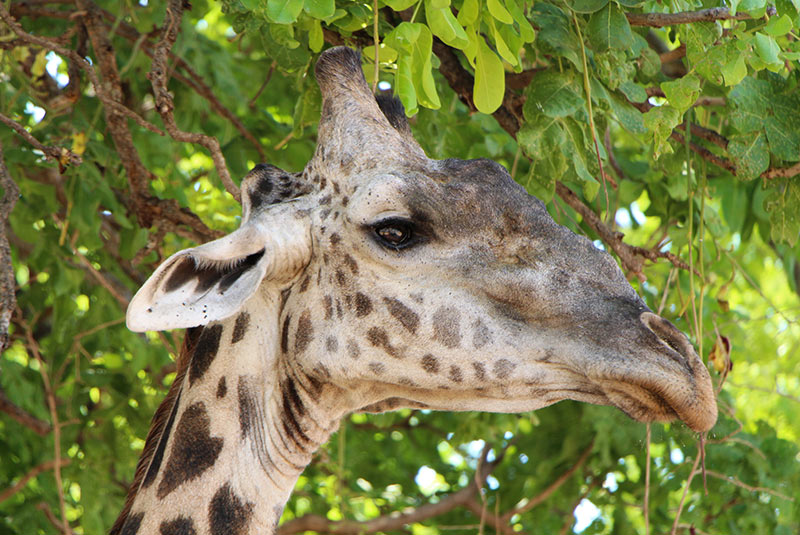
In the late September heat, this old male giraffe didn’t really care how close we were in our vehicle; he did not want to retreat from his shade.
Fact about giraffes: They are more endangered than previously thought. Their plight has even been called a “silent extinction.” With habitat loss for human economic development as a major pressure point, it’s all the more important that you safari responsibly and take care to invest back in the communities you visit through wildlife tourism. Which brings me to my next point…
Zambia Safari Lodges & Responsible Travel
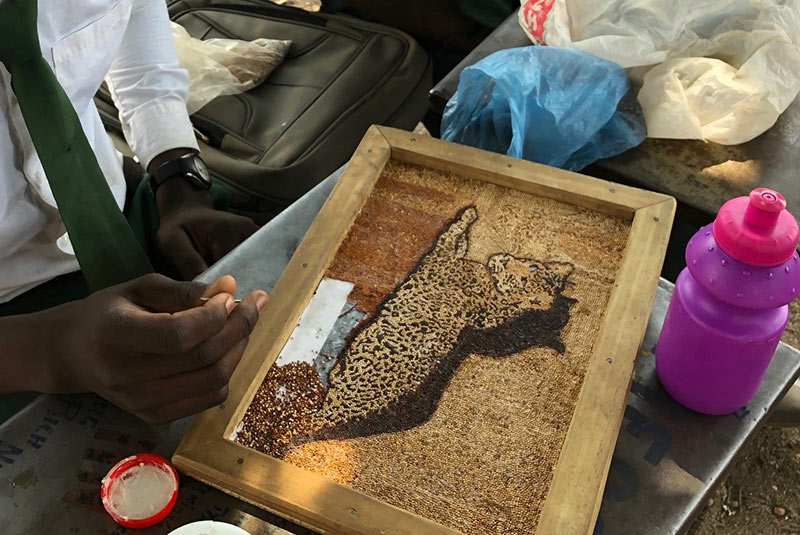
In Zambia, tourism and community are visibly linked. A major lesson of my safari was that a trip to Africa must not serve only the visitor. We have a responsibility to work with sustainable and responsible tour operators and lodges, to contribute not only to conservation, but to communities.
All guests of Mfuwe Lodge and the Bushcamp Company contribute through their stay to the Luangwa Conservation and Community Fund. What does that mean in real terms? It means guests’ stays here have sponsored students, paid teacher salaries, and built classrooms at two local schools; drilled more than 40 boreholes to provide clean water back to the villages where so many of the guides and staff grew up; and contributed to the Meal-a-Day program, which feeds 2,000 students daily. Visiting Mfuwe Secondary school brought the whole trip home for me, and I was particularly moved when we dropped in on an art class. Simon allowed me to photograph his work, pictured above. His leopard is designed entirely with millet seeds, and he’s been working on it painstakingly for months. With the commitment of these students, you really do feel that the future is in good hands.
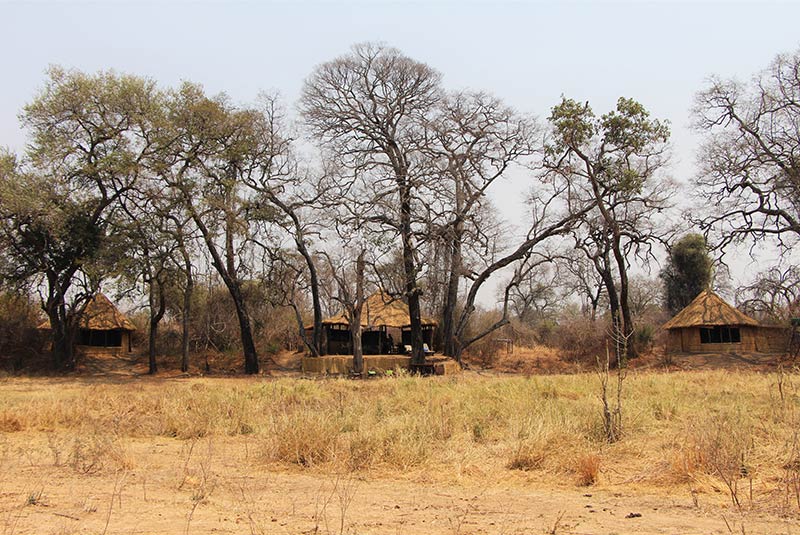
Remote Africa Safaris lives up to the name. After your canoe takes you across the Luangwa River, you are in the territory of Chikoko Trails, a camp-to-camp walking concept. The camps are essentially rebuilt every year, with just the sturdy wood frames left as a testament to their presence in the wet season. From an oven in the earth, miracles are worked: casseroles, cakes, and pies. With just three thatched rooms at each camp and absolutely no Internet access, you are here to connect with the environment, yourself, and others. We spent evenings sitting around simmering fires while discussing everything from NASA space exploration to animal psychology, never running out of wonder.
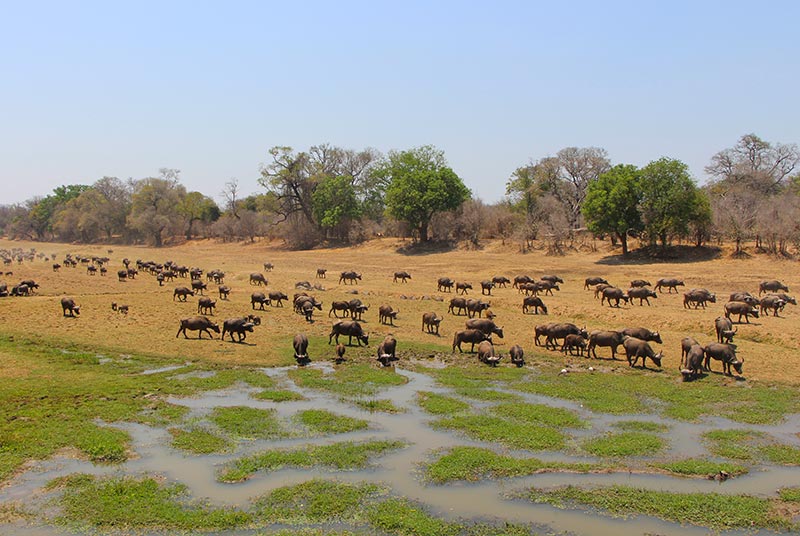
We arrived at Mfuwe Lodge in time for a build-your-own pizza lunch and a lounge by the pool, and then suddenly it was as if someone opened a gate for 300 buffalo to wander before our eyes—massive game-viewing without even leaving the deck.
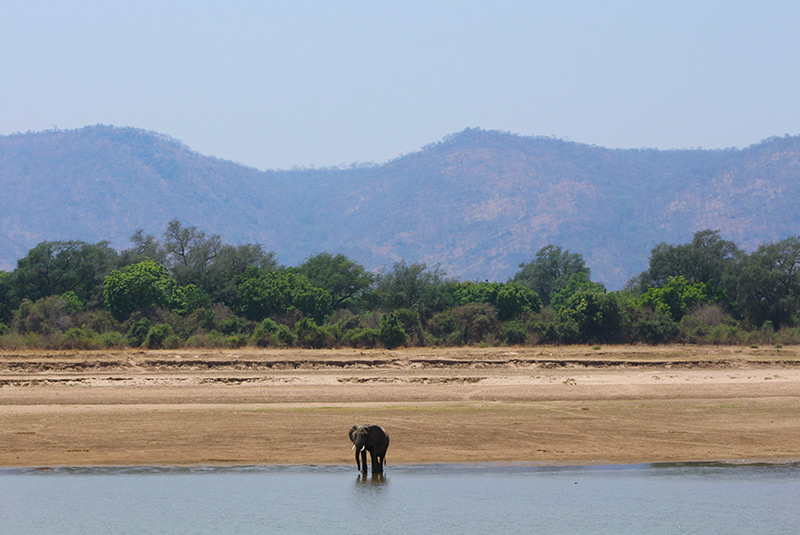
On the way to Chindeni Bushcamp, deep in the southern reaches of South Luangwa National Park, we paused to stretch our legs and admire the Chindeni Hills and Luangwa River. Presumably, this elephant on the opposite bank also paused to admire us.
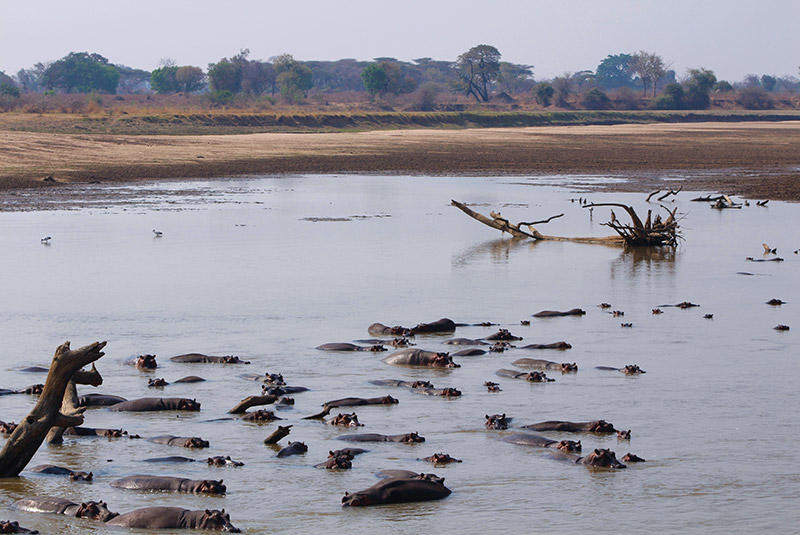
How many hippos are in the Luangwa River? Guess correctly and win a prize.
Luxury Zambia Safaris
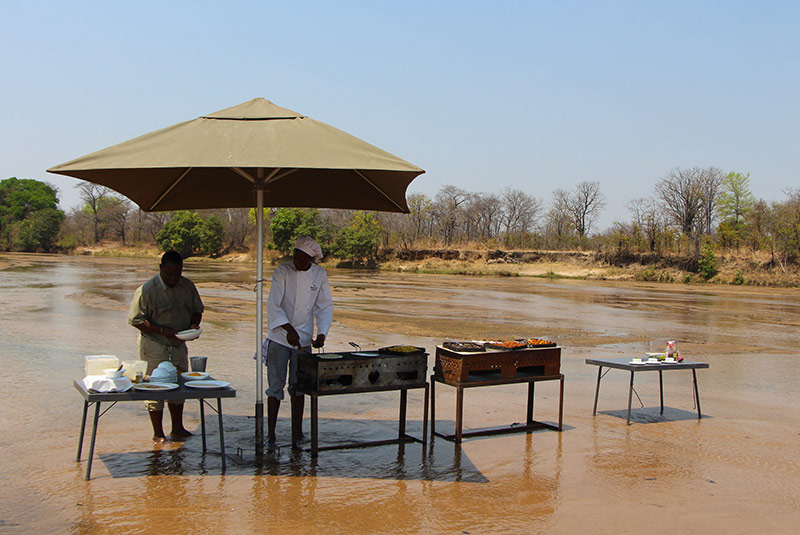
Have you ever dined at a white-tablecloth lunch with a cold beer in your hand and your feet in a river? Has your view included both the chef-made vanilla ice cream in the foreground and elephants in the distance? If not, let’s please add this to your “to do in Africa” list. We came upon this surprise setup after bidding a sad farewell to the comforts and friendly staff of the remote and romantic Kapamba Camp, and the sight of this in-river spread brightened our spirits.
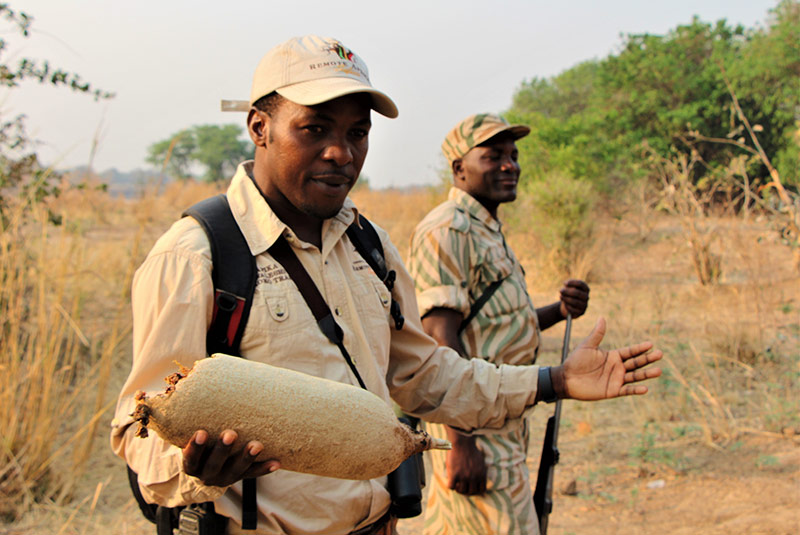
As any walking guide will tell you, walking safaris are not just about the big game. On the Chikoko Trails, our guide Moffat filled us in on the sausage fruits we saw littering the ground around us (they’re good for tsetse fly bite relief). Walking safaris are slower-paced than a game drive. Without four wheels and a chassis, you can’t cover the same amount of ground or approach a predator as closely. What you can do is hear Africa without the rumble of an engine. You can stop to smell those mahogany flowers rather than zoom obliviously by the tree, and you can even taste the sour-sweet pulp of a tamarind.
We learned how to identify the tracks of a porcupine, its quills dragging behind it, versus those of a hippo, with his chin hairs dragging on the ground. Our silence was disturbed by the urgent chatter of a honeyguide, a bird species that long ago struck a deal with humans—she lures you to a beehive so that you can benefit from the honey and she can swoop in to finish up the exposed larvae you leave behind. We watched an ant lion pounce on an ant from his fortress under the sand and learned that there are more than 300 species of fig tree and that each tree has a corresponding species of wasp to pollinate it.
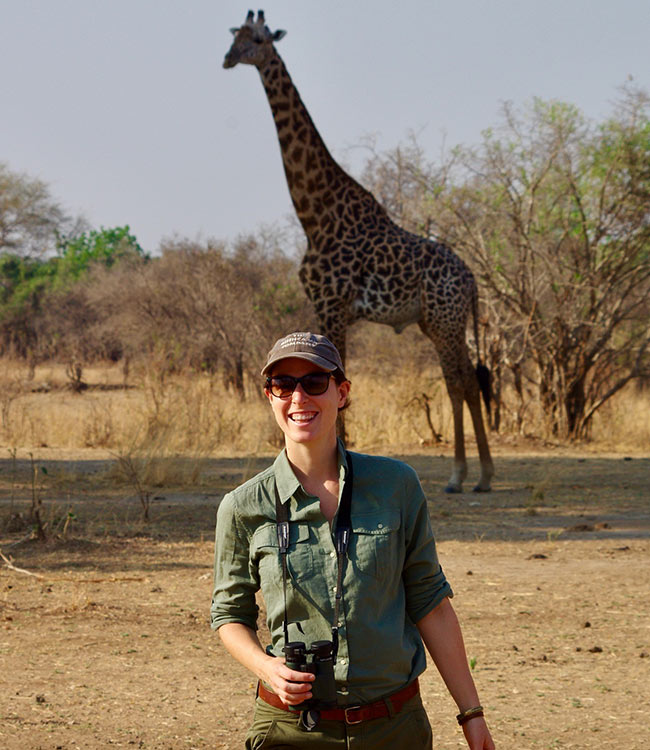
Photo: Caspar Venter
Although the focus of a walking safari may be on the microscopic at times, there are still the “wow” moments where you lift your eyes to refocus and realize you’re sharing the same ground as an iconic species, like this South Luangwa giraffe near Chindeni Bushcamp.
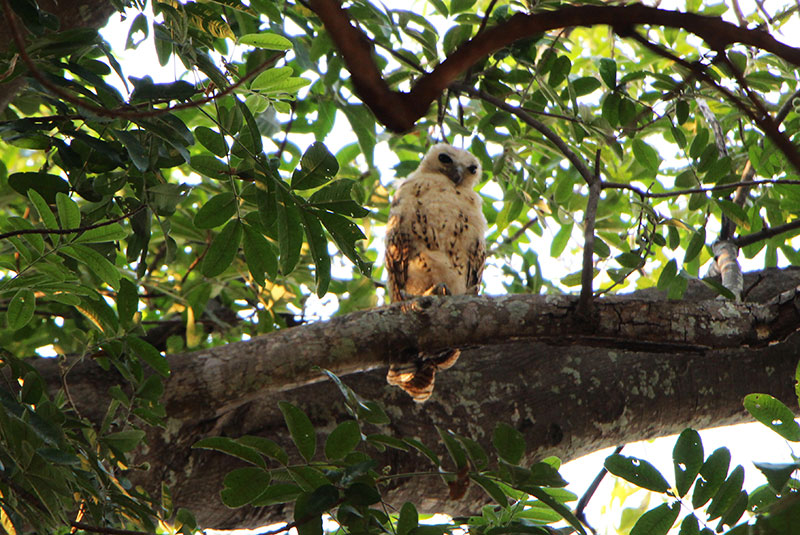
This was a prize moment, because Pel’s fishing owl is a lifetime treat for birders, and on our walk we were able to sit nearly right beneath one for a generous amount of time.
Here’s a photo of a kill! Perhaps not with the gore of National Geographic, but above is a white-fronted bee-eater—one of Zambia’s most beautiful birds, in my opinion—dining on an insect. White-fronted bee-eaters can enjoy up to 300 feeding sessions a day, something I could relate to on this safari, but I still always showed up for afternoon tea.
# # # # #
GeoEx’s Jessica Silber is an expert in planning safaris and cultural tours. She’s lived in Tanzania and traveled throughout Kenya, Botswana, and Mozambique. She has trekked with gorillas in the Republic of the Congo, explored the souks of Morocco, visited mosques in Iran, and much more.
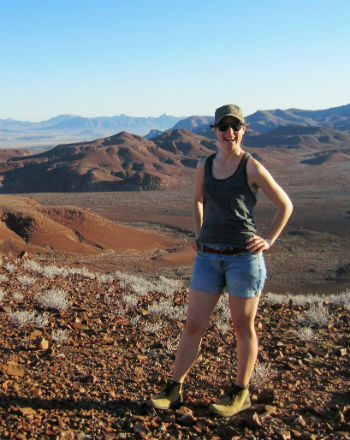
For more information on options for custom Zambia safaris or on other safari destinations, call Jessica or another GeoEx destination specialist at 888-570-7108.
What a wonderful description for someone who would never be able to do such a travel experience!! Thank You!!!

